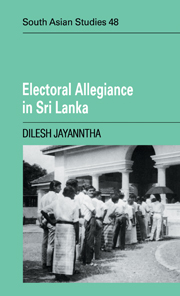Book contents
- Frontmatter
- Contents
- Acknowledgments
- List of abbreviations
- 1 Introduction
- 2 Bluville: the constituency and the patronage network of Doctor Ay (1947–1959)
- 3 Bluville: the patronage network of Korale-Mudaliyar Kit Foo and his son, Dee (1947–1959)
- 4 Bluville: the growth of the State (1956–1982)
- 5 Greenville: the patronage networks of the Mou/Nous and the Pou/Kous (1947–1959)
- 6 Greenville: the growth of the State (1956–1982)
- 7 Red Town: the urban setting (1947–1959)
- 8 Red Town: the growth of the State (1956–1982)
- 9 Communal minorities, political dissidents and the JVP
- 10 Conclusion
- Glossary of Sinhalese Terms
- References
- Index
- CAMBRIDGE SOUTH ASIAN STUDIES
9 - Communal minorities, political dissidents and the JVP
Published online by Cambridge University Press: 11 September 2009
- Frontmatter
- Contents
- Acknowledgments
- List of abbreviations
- 1 Introduction
- 2 Bluville: the constituency and the patronage network of Doctor Ay (1947–1959)
- 3 Bluville: the patronage network of Korale-Mudaliyar Kit Foo and his son, Dee (1947–1959)
- 4 Bluville: the growth of the State (1956–1982)
- 5 Greenville: the patronage networks of the Mou/Nous and the Pou/Kous (1947–1959)
- 6 Greenville: the growth of the State (1956–1982)
- 7 Red Town: the urban setting (1947–1959)
- 8 Red Town: the growth of the State (1956–1982)
- 9 Communal minorities, political dissidents and the JVP
- 10 Conclusion
- Glossary of Sinhalese Terms
- References
- Index
- CAMBRIDGE SOUTH ASIAN STUDIES
Summary
General
In the preceding seven chapters we have looked at patronage networks, essentially confined to the Sinhala Buddhist population. However, certain racial and religious minorities have a distinct identity of their own and tend to vote en bloc, generally, for a particular party. In this chapter we shall first look at these minorities in the electorates we have studied. We shall then look at certain leftist groups operating outside the arena of formal electoral politics, and especially at the emergence and development of the ‘Janatha Vimukthi Peramuna’ (or ‘People's Liberation Front’), better known as the JVP.
In Greenville in 1946 Buddhists constituted just over 90 per cent of the population, and the Sinhalese a similar proportion. After the 1959 delimitation their proportions had risen, and after the 1976 delimitation these proportions rose still further. No one religious or racial minority accounted for more than 3 per cent of the electorate's population at any one time. The minorities, where they did exist, were dispersed, often in trading ventures, reasonably well assimilated with the majority Sinhala Buddhists, and electorally insignificant as a separate bloc.
In our other two electorates, however, the situation was different. In Bluville the Muslims formed a cohesive bloc, concentrated in the Zoville area. In 1946 they accounted for just under a twentieth of the electorate's population, and for slightly higher proportions after the delimitations of 1959 and 1976. In Red Town the Christians also constituted a distinct, self-conscious and somewhat insular group, concentrated in the urbanized western part of the electorate. In 1946 they accounted for about a seventh of the electorate's population, and this proportion did not change significantly after the delimitations of 1959 and 1976.
- Type
- Chapter
- Information
- Electoral Allegiance in Sri Lanka , pp. 183 - 198Publisher: Cambridge University PressPrint publication year: 1992
- 1
- Cited by



